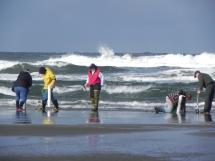OLYMPIA – Washington Department of Fish and Wildlife (WDFW) shellfish managers confirmed today the first round of razor clam digging opportunities at Long Beach, Twin Harbors, and Copalis from Sept. 28-30.
“After taking a short pause to allow for more marine toxin testing, we’re happy to report that razor clams on these beaches are safe to eat and pleased to get digging started,” said Dan Ayres, WDFW coastal shellfish manager. “As usual, we’ll continue to test and monitor the situation closely prior to all future planned openings.”
The following digs during evening (p.m.) low tides will proceed as scheduled, after marine toxin results from the Washington Department of Health (DOH) showed razor clams are safe to eat:
- Sept. 28, Wednesday, 9:06 p.m.; -0.3 feet; Long Beach, Twin Harbors, Copalis
- Sept. 29, Thursday, 9:51 p.m.; -0.4 feet; Long Beach, Twin Harbors
- Sept. 30, Friday, 10:43 p.m.; -0.2 feet; Long Beach, Twin Harbors, Copalis
WDFW conducted summer assessments showing a strong razor clam population except at Kalaloch, which is closed for 2022-2023 season. More tentative dates are planned on Oct. 8-14, Oct. 24-30, and during November and December. The 2021-2022 season generated a record turnout of diggers and high number of razor clams harvested.
Not all beaches are open for every dig, so diggers are encouraged to make sure their intended destination is open before heading out. The most successful digging occurs between one and two hours before the listed time of low tide.
Digging is prohibited in the razor clam reserves, which are marked by 10-foot poles with signs. The reserves are located just south of the Ocean City approach on Copalis; and 2.8 miles north of the Oysterville approach on Long Beach.
The daily limit is 15 razor clams per person. Under state law, a daily limit consists of the first 15 clams dug regardless of size or condition, and each digger’s clams must be kept in a separate container.
All diggers age 15 or older must have an applicable fishing license to harvest razor clams on any beach. Licenses may be purchased on WDFW’s licensing website, and from hundreds of license vendors around the state. Options include a three-day razor clam license to an annual combination fishing license. WDFW recommends buying your license before visiting coastal beach communities.
For more information on future tentative digs, go to the WDFW's razor clam webpage. The updated 2022-23 Razor Clam Management Plan is available on the WDFW’s website. Public comments on the plan will be accepted no later than Oct. 15 and may be emailed to razorclams@dfw.wa.gov.
The Washington Department of Fish and Wildlife works to preserve, protect, and perpetuate fish, wildlife and ecosystems while providing sustainable fish and wildlife recreational and commercial opportunities.
Individuals who need to receive this information in an alternative format, language, or who need reasonable accommodations to participate in WDFW-sponsored public meetings or other activities may contact the Title VI/ADA Compliance Coordinator by phone at 360-902-2349, TTY (711), or email (Title6@dfw.wa.gov). For more information, see https://wdfw.wa.gov/accessibility/requests-accommodation.

Original source can be found here.





 Alerts Sign-up
Alerts Sign-up